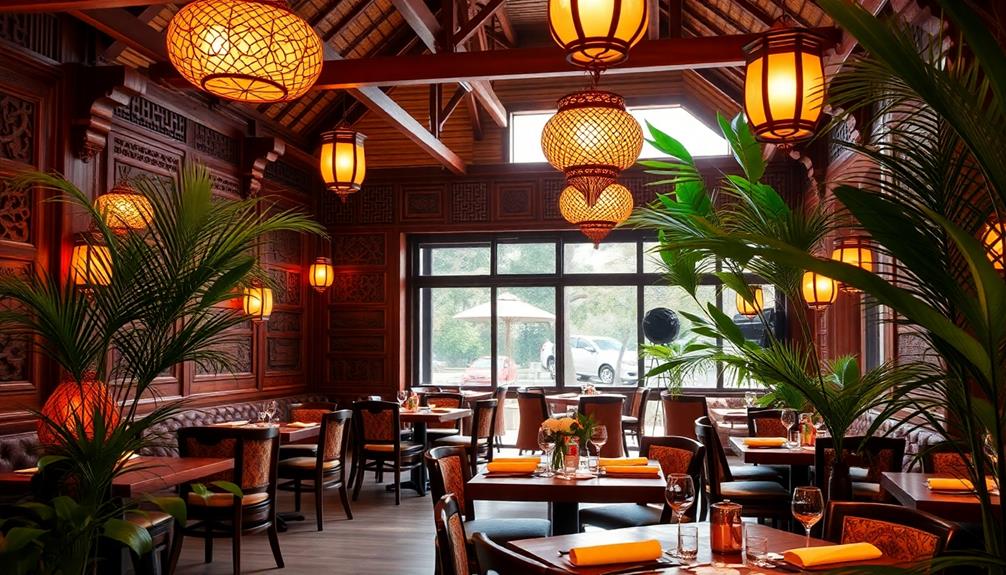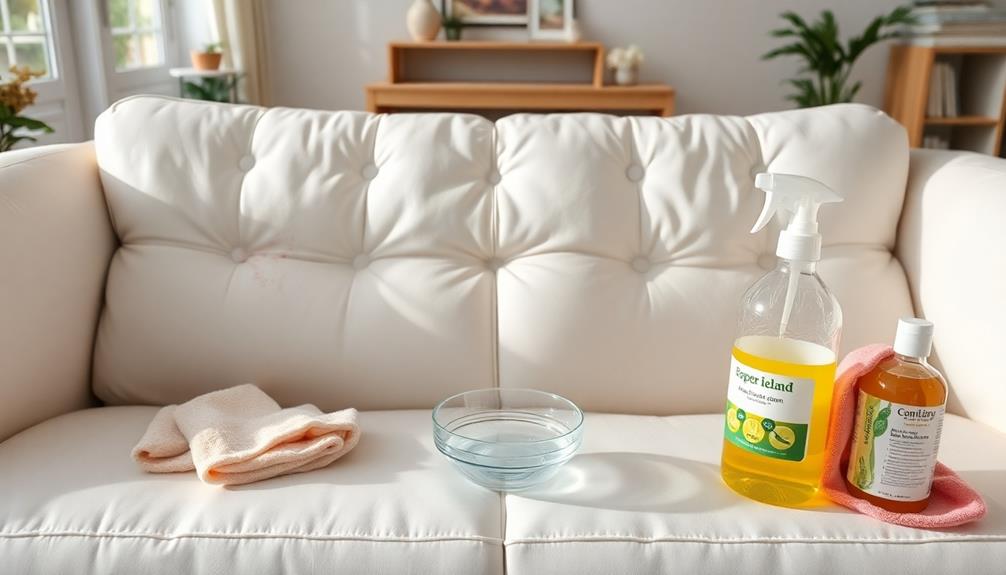To impress your guests with cultural sophistication at your Indonesian dining establishment, consider incorporating vibrant colors and natural materials. Integrate rich reds and deep blues reminiscent of local fabrics to infuse energy and warmth into the ambiance. Enhance authenticity by incorporating traditional art forms like batik prints and ikat patterns. Showcase cultural artifacts such as masks and sculptures to share the diverse stories of Indonesia. Prioritize sustainable practices by utilizing eco-friendly materials like bamboo and reclaimed wood. Blend traditional elements with modern design to offer a distinctive dining experience that captivates patrons. By delving deeper, you can discover even more inspiring ideas to enhance the interior of your restaurant.
Key Takeaways
- Utilize vibrant colors like rich reds and deep blues to reflect Indonesia's cultural vibrancy and enhance visual appeal.
- Incorporate traditional art forms such as batik prints and ikat patterns to add cultural identity and tactile interest to the decor.
- Emphasize sustainable practices by using natural materials like bamboo and reclaimed wood, fostering a connection with nature.
- Create inviting atmospheres with harmonious furniture arrangements and layered textures, promoting warm and welcoming dining experiences.
- Integrate unique cultural artifacts, such as traditional masks and sculptures, to narrate Indonesia's diverse traditions and enhance the overall dining experience.
Design Inspiration From Indonesia
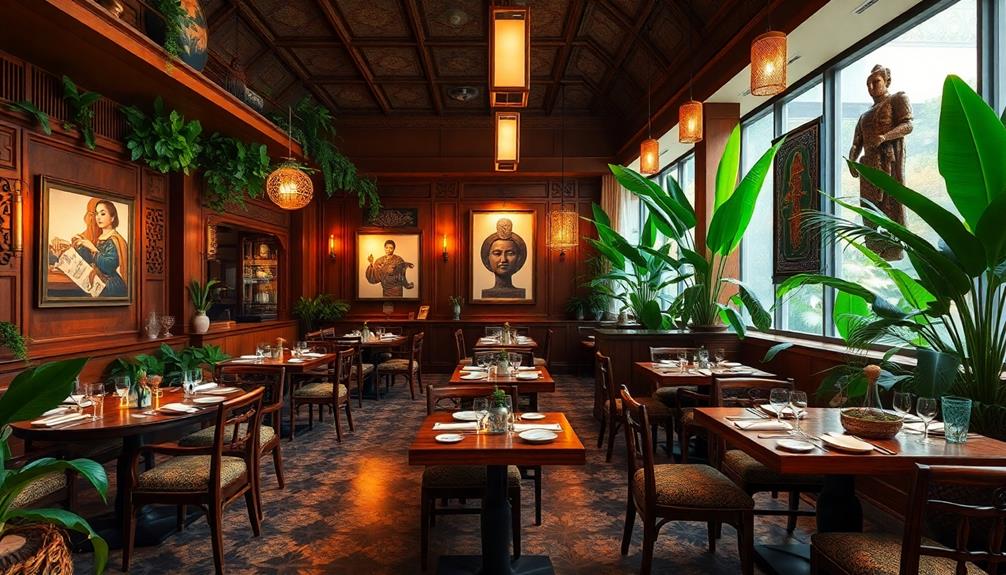
When you step into an Indonesian restaurant, you're immediately struck by the vibrant colors that reflect the country's rich culture. The interior design often showcases traditional Indonesian hues, with rich reds and deep blues creating an energetic and inviting atmosphere.
You'll notice the use of natural materials like rattan, bamboo, and antique wood, emphasizing sustainability while adding a warm, organic beauty to the dining space. To enhance comfort and cultural authenticity, many restaurants incorporate Indonesian decorative pillows that feature intricate patterns and vibrant colors, making the seating arrangements even more inviting.
As you take in the surroundings, you'll see traditional art forms integrated into the decor. Batik prints and ikat patterns enhance the visual appeal, adding layers of cultural identity. The presence of cultural artifacts, such as traditional masks and sculptures, narrates Indonesia's diverse traditions, enriching the overall ambiance.
The design principles focus on achieving harmony between humans, nature, and the divine. This guiding philosophy influences the arrangement of furniture and the layout of the restaurant, creating an immersive dining experience.
Every element, from color to texture, comes together to celebrate traditional Indonesian culture, making your visit not just a meal but a journey through Indonesia's vibrant heritage.
Key Elements of Cultural Elegance
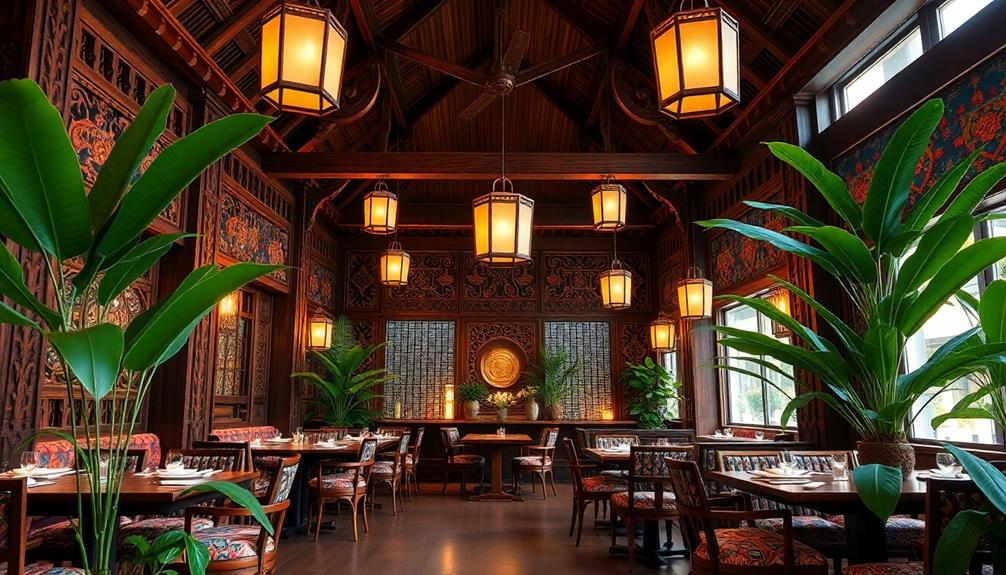
Embracing the essence of cultural elegance in an Indonesian restaurant involves a thoughtful blend of design elements that resonate with the rich heritage of the archipelago. Start by incorporating vibrant colors inspired by local textiles, like rich reds and deep blues, to enhance the energy and visual appeal of your space.
Use natural materials such as rattan, bamboo, and antique wood, which evoke warmth and comfort while emphasizing sustainability. Consider incorporating traditional artistry through unique decor pieces like Indonesian masks, as they add an authentic touch and enhance the overall aesthetic of your restaurant.
Integrating cultural artifacts—think traditional masks and sculptures—provides visual storytelling that reflects Indonesia's diverse cultural heritage and craftsmanship. These elements not only intrigue your guests but also create a connection to the cultural diversity of the region.
Additionally, employing intricate patterns from traditional textiles, such as batik and ikat, adds a tactile interest and cultural identity to your decor.
Lastly, focus on design principles that cultivate harmony between humans, nature, and the divine. This approach helps create an inviting atmosphere that resonates with Indonesia's rich traditions, making your restaurant a true celebration of cultural elegance.
Successful Restaurant Design Examples
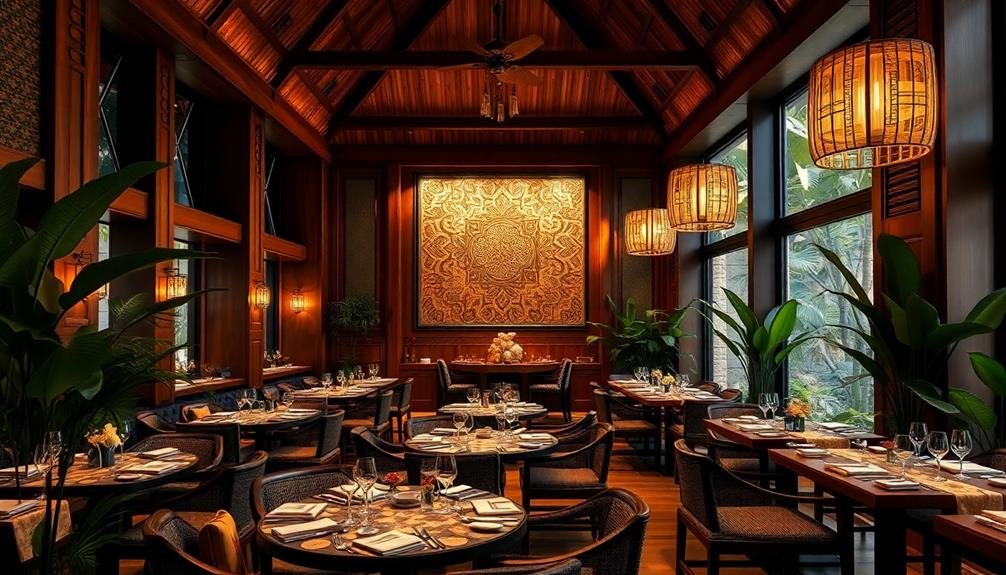
When you explore successful Indonesian restaurant designs, you'll notice how innovative approaches blend seamlessly with cultural elements.
Restaurants like Coffee Toebroek and Tugu create inviting atmospheres that celebrate local heritage while using sustainable materials.
By incorporating natural materials and earth tones, these spaces enhance the overall dining experience and promote a sense of tranquility, reflecting Balinese design characteristics.
These examples highlight the importance of integrating tradition with modern design to enhance the dining experience.
Innovative Design Approaches
Transforming the dining experience in Indonesian restaurants involves innovative design approaches that blend tradition with modernity. Restaurants like Coffee Toebroek exemplify this by modernizing traditional Indonesian aesthetics while using sustainable materials. You'll notice biophilic elements, such as bamboo and rattan, that connect diners with nature.
Another standout is Lara Djonggrang in Jakarta, where historical themes create an immersive experience. It celebrates Indonesia's rich cultural heritage, combining decor and menu offerings that tell a story. The integration of local art, including traditional masks and textiles, adds cultural depth to your dining environment.
Looking ahead, future design approaches are focusing on outdoor dining spaces and technology integration to enhance ambiance and engagement. These elements not only provide a unique dining experience but also cater to the evolving preferences of guests.
| Design Element | Description |
|---|---|
| Sustainable Materials | Utilizes eco-friendly options like bamboo |
| Biophilic Design | Incorporates natural elements for tranquility |
| Local Art Integration | Showcases traditional artifacts for storytelling |
Cultural Elements Integration
Integrating cultural elements into restaurant design creates a unique dining experience that reflects Indonesia's rich heritage. Successful examples like Coffee Toebroek showcase modern interpretations of traditional aesthetics, enhancing the ambiance with culturally rich environments.
This restaurant emphasizes cultural elements integration by using sustainable materials, a trend popularized by Kevin Aldric Interior. Adding unique art pieces, such as Indonesian decor masks, can further enrich the dining space, offering a glimpse into the vibrant artistic expressions of Indonesia.
You can enrich your restaurant's decor by incorporating cultural artifacts such as traditional masks and textiles, which provide visual storytelling that showcases Indonesia's diversity. In the Ubud dining scene, you'll notice how local flavors and authentic designs come together, celebrating both traditional and contemporary Indonesian culture.
Incorporating vibrant color palettes inspired by local textiles and landscapes not only enhances the aesthetic appeal but also connects diners to Indonesia's cultural identity.
Imagine walking into a luxurious hotel-inspired space where every detail, from the furniture to the wall art, tells a story of the local heritage. By thoughtfully integrating these elements, you create an inviting atmosphere that resonates with your guests, encouraging them to immerse themselves in the richness of Indonesian culture while enjoying their meal.
Sustainable Design Practices
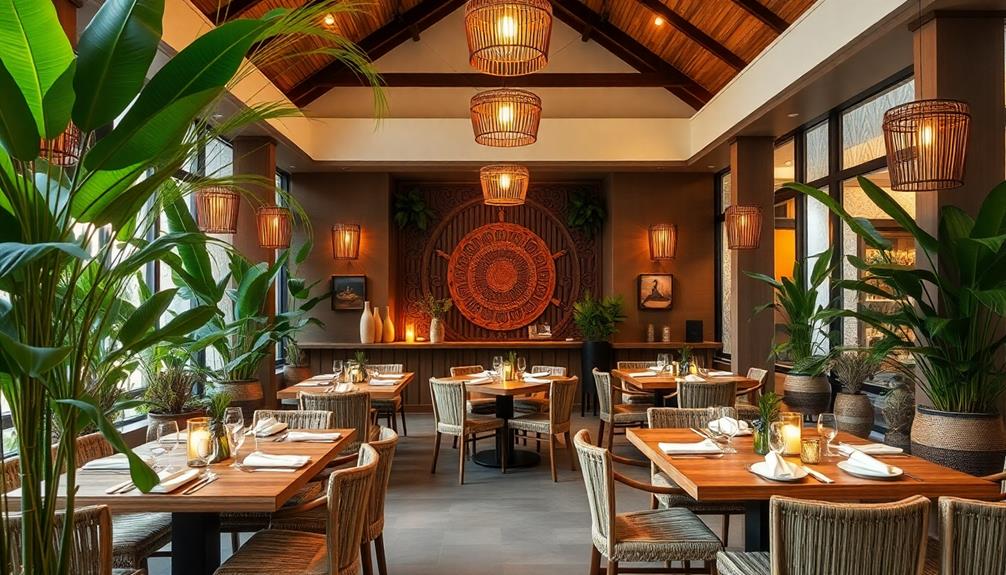
When designing an Indonesian restaurant, you'll want to prioritize eco-friendly materials like bamboo and reclaimed wood to lessen your environmental impact.
These materials not only reflect the traditional Rumah Adat aesthetic but also promote sustainability.
By implementing energy efficiency strategies, such as natural ventilation and lighting, you can create a more sustainable space.
Plus, integrating biophilic design elements, like indoor plants, not only enhances the atmosphere but also improves air quality for your guests.
Eco-Friendly Material Selection
In recent years, eco-friendly material selection has become a cornerstone of sustainable design practices in Indonesian restaurant interiors.
By choosing eco-friendly materials like bamboo, rattan, and reclaimed wood, you not only reduce your environmental impact but also enhance the aesthetic appeal of your space.
These natural materials foster a sense of harmony and tranquility that aligns beautifully with traditional Indonesian design principles, as seen in traditional Indonesian style home decor.
Consider these key aspects when selecting materials:
- Local Sourcing: Supporting local artisans reduces transportation carbon footprints and promotes community growth.
- Recycled Elements: Incorporating recycled materials adds unique character and storytelling to your restaurant's decor.
- Non-Toxic Finishes: Using low-VOC paints keeps indoor air quality safe for guests and staff, showcasing your commitment to health.
- Natural Textures: The tactile quality of eco-friendly materials creates an inviting atmosphere, encouraging guests to linger.
Energy Efficiency Strategies
Creating an energy-efficient Indonesian restaurant isn't just about saving on utility bills; it's about fostering a sustainable environment that resonates with your values. By implementing effective energy efficiency strategies, you can create a welcoming space while minimizing your environmental footprint.
Here are some strategies to evaluate:
| Strategy | Benefits |
|---|---|
| LED Lighting | Reduces electricity consumption and enhances ambiance. |
| Natural Ventilation | Improves air circulation, cutting down on mechanical cooling needs. |
| Programmable Thermostats | Optimizes energy use based on occupancy, ensuring comfort and efficiency. |
Incorporating natural materials like reclaimed wood and bamboo not only aligns with sustainability but also enhances the aesthetic appeal of your restaurant, reflecting the rich Indonesian culture. Proper insulation and energy-efficient HVAC systems help maintain comfortable temperatures, reducing energy wastage.
Biophilic Design Integration
Integrating biophilic design into your Indonesian restaurant not only enhances the aesthetic appeal but also strengthens the connection between your guests and nature. By incorporating natural elements, you create a calming atmosphere that invites diners to relax and enjoy their meals.
Consider the following strategies to elevate your interior design:
- Use sustainable materials like reclaimed wood and bamboo to infuse warmth and authenticity into your space, reflecting the modern tropical aesthetics that are prevalent in Balinese architecture.
- Incorporate living plants to improve air quality and promote a vibrant, inviting environment.
- Maximize natural light through large windows or skylights, enhancing the overall dining experience.
- Design open layouts and outdoor dining areas to create a seamless flow between the interior and exterior.
Recent trends indicate that restaurants embracing biophilic design not only foster guest satisfaction but also see increased customer retention and longer dining durations.
By implementing these practices, you're not just making a design choice; you're investing in a sustainable future and a memorable dining experience that resonates with your patrons.
Your attention to nature will cultivate an atmosphere that's both unique and comforting, setting your restaurant apart in the competitive culinary scene.
Creating an Inviting Atmosphere
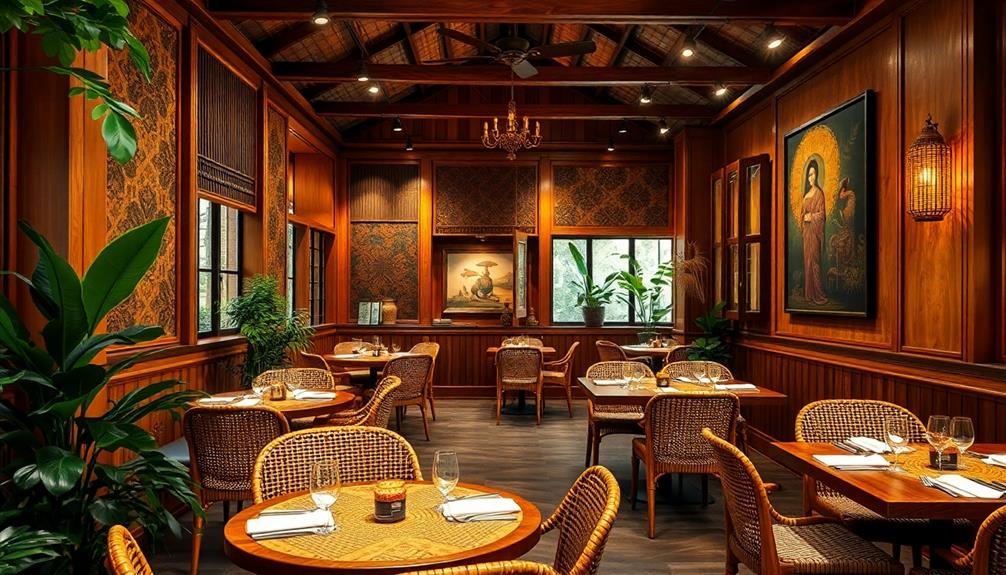
Creating an inviting atmosphere in an Indonesian restaurant can transform a meal into a memorable experience. To achieve this, consider incorporating vibrant colors inspired by local textiles, such as rich reds and earthy tones. These hues can energize the space while creating warmth.
Using natural materials like bamboo, rattan, and antique wood not only enhances the inviting atmosphere but also emphasizes sustainability and eco-friendliness in your design. Additionally, showcasing Indonesian decor masks can add a unique cultural touch that fascinates guests and sparks conversations.
Integrating traditional Indonesian art pieces, like masks and sculptures, provides engaging decor that tells cultural stories, enriching your guests' dining experience. Layering textures through rugs, tapestries, and unique textiles adds depth, making the environment visually appealing and tactile, encouraging guests to feel right at home.
Lastly, focus on harmony when arranging furniture and incorporating elements of nature. A well-balanced space fosters a serene and welcoming ambiance, inviting diners to relax and enjoy their meals.
Ubud's Culinary and Design Scene
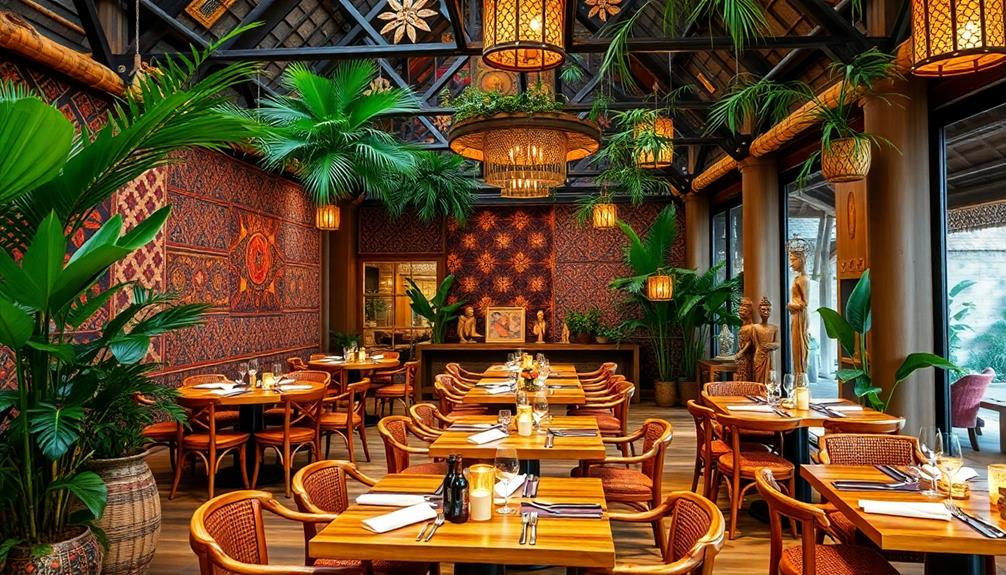
In Ubud, Bali's culinary and design scene thrives on a unique blend of authenticity and innovation. You'll find a vibrant array of dining options that celebrate traditional Indonesian cuisine while incorporating local flavors.
Many restaurants collaborate with local designers to create spaces that reflect luxury tropical design aesthetics, ensuring that the environment complements the culinary experience. Whether you're in a luxury hotel's fine dining restaurant or a charming café, the emphasis on local ingredients and cultural themes enriches your dining experience.
Many restaurants in Ubud showcase stunning interior designs that reflect Balinese aesthetics, creating an inviting atmosphere. Here are some elements you can expect:
- Sustainable materials: Eco-friendly practices are becoming essential in restaurant designs.
- Open-air layouts: Many venues embrace the natural beauty of Ubud, blurring the lines between indoors and outdoors.
- Artisan decor: Handcrafted elements often adorn spaces, celebrating local craftsmanship.
- Innovative menus: Chefs craft modern interpretations of traditional dishes, appealing to diverse palates.
This seamless integration of culinary artistry and thoughtful design not only enhances your dining experience but also showcases Ubud's commitment to preserving its rich culture.
Exploring Related Design Trends
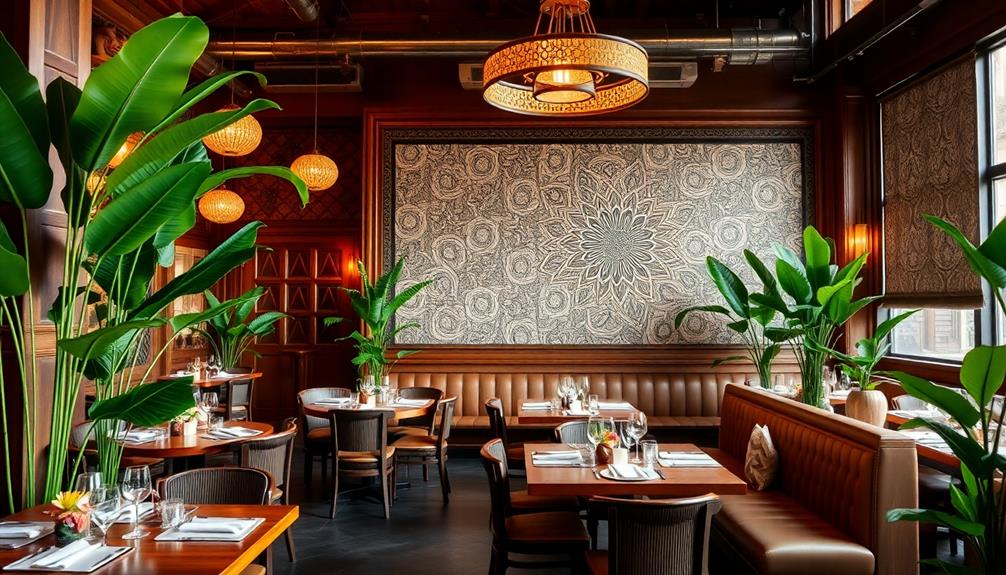
Exploring the latest design trends in Indonesian restaurants reveals a fascinating blend of tradition and modernity that captivates diners.
You'll notice how cultural elements, like traditional textiles such as batik and ikat, enhance the visual identity of the space, creating an authentic dining atmosphere. These textiles not only reflect Indonesia's rich heritage but also engage guests on a deeper level.
Incorporating vibrant color palettes reminiscent of Indonesian culture can further elevate the ambiance, while elements like intricate wood carvings can serve as stunning decor pieces that celebrate local craftsmanship traditional batik patterns.
Sustainability plays a key role in contemporary designs. Many restaurants now prioritize eco-friendly materials and practices, showcasing a commitment to environmental responsibility.
You might find biophilic design principles woven into these spaces, with natural elements and greenery fostering a connection to nature, greatly enhancing the dining experience.
Local craftsmanship is another trend taking center stage. By incorporating locally made furniture and decor, restaurants not only support artisans but also provide a genuine sense of place.
You'll likely see modern Indonesian designs marrying traditional aesthetics with contemporary features, appealing to today's diners while honoring the past. This fusion of old and new guarantees that guests not only enjoy a meal but also immerse themselves in a culturally rich environment. The use of Indonesian style interior design often incorporates natural materials such as teak wood, rattan, and batik fabrics, creating a warm and authentic atmosphere. Additionally, vibrant patterns and earthy tones reflect Indonesia’s diverse heritage, while sleek, minimalist furniture introduces a modern touch. This harmonious blend ensures that the space feels both timeless and fresh, resonating with a broad range of patrons.
Frequently Asked Questions
How Do You Wow a Guest in a Restaurant?
To wow your guests, create an inviting atmosphere with warm lighting and unique decor. Offer exceptional service, curate a memorable menu, and guarantee every detail enhances their experience, making them feel valued and special throughout their visit.
How to Make a Restaurant Interior Design?
"Beauty is in simplicity." To make your restaurant's interior design pop, blend vibrant colors and natural materials, arrange seating for comfort and flow, and incorporate unique decor that tells a story and invites guests in.
Conclusion
In the end, if you want your Indonesian restaurant to scream "cultural elegance," just throw in some bamboo, batik, and a few strategically placed rice paddies. Your guests will feel like they've stepped into a Balinese paradise—complete with the aroma of fried tempeh wafting through the air. Who needs authenticity when you can just slap on some decor and call it a day? Remember, it's all about appearances, right? Bon appétit and good luck!
